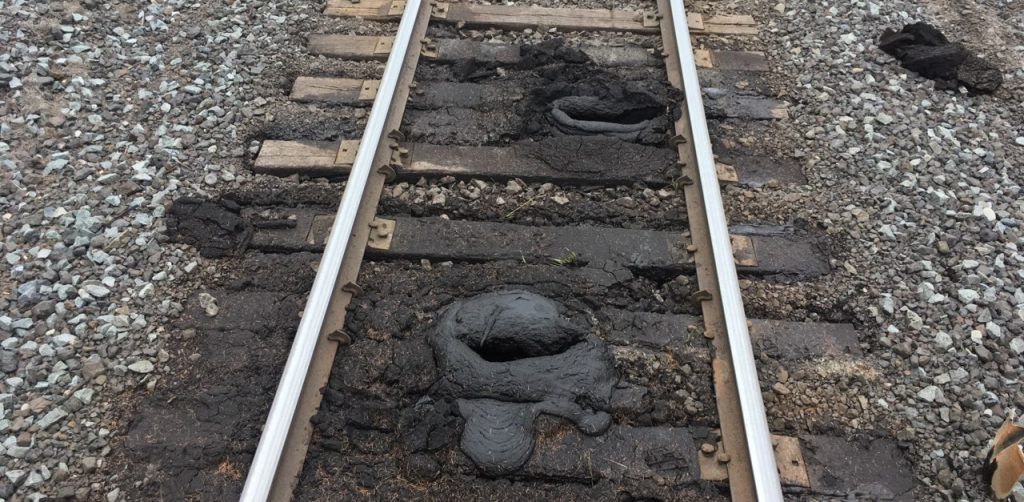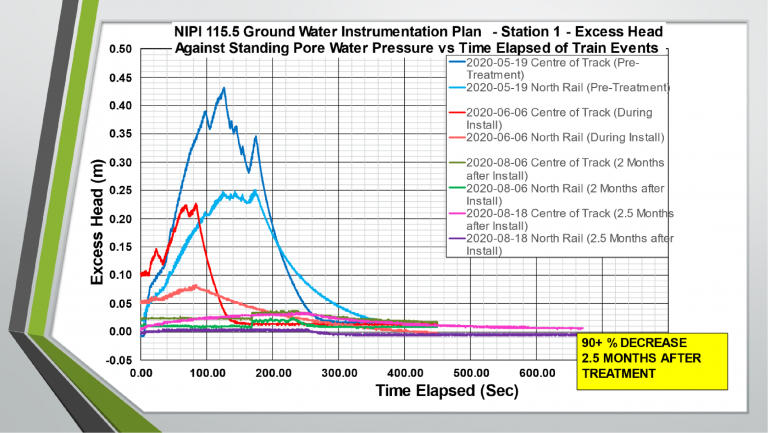Current State of Development
Spring Drains Treatment Options and Considerations
Updated April 2024
What is a peat boil?

A peat boil forms when a zone of peat below the railway embankment has liquified under dynamic train loading. Excess porewater pressures as high as 4m of head have been measured during the passing of a train. The liquified peat is of very low strength which causes the embankment fills to fall into the zone of peat, forming a hole in which the liquified peat ejects.
Peat Boil/Mud Spot developments have been increasing as a result of longer and heavier trains running at a greater frequency to meet the shipping demands of our growing global economies.
Traditional treatments have involved lengthy track blocks to allow for removal of underlying peat/soft soils and reinstatement with rock fill. Alternative treatments have included helical piles, geo-spikes, and stabilized soil treatments beneath the rail.
None of the traditional nor alternative methods are as effective as the Spring Drain for its ability to cost-effectively treat Peat Boils and Mud Spots with limited impact to rail traffic as the installation is completed without disruption to rail infrastructure and completed in between trains thus avoiding operational impacts.



USA and Canadian Patents were secured in 2019
The Patents are held by TBT Engineering and identify Gord Maki, P. Eng. as the Inventor.
In 2020, we completed a $ 500,000 supply and installation project for a major Canadian Railway.
We have secured orders for the 2021 season and are looking to expand our markets to include additional National and Regional Railway clients that can benefit from this innovative product.

Spring Drains allow for expedited porewater pressure dissipation while also providing effective load transference into underlying competent soil strata.
Spring Drains provide for effective porewater pressure dissipation and elimination of Peat Boils based on visual observations after one year.

For more information on Spring Drains please contact the following:
Rob Frenette, P.Eng
Managing Director of TBT Engineering
M: 807-626-6639
Email: rfrenette@tbte.ca
Gord Maki, P.Eng
Vice President, Earth & Environmental of TBT Engineering
M: 807-621-1335
Email: gmaki@tbte.ca
Danny J Wong, P.Eng.
Director Geotechnical Engineering, CP
The formation of peat boils has become increasingly problematic for CP Railway and its operations. Peat boils lead to increased risks of track instability, creates ongoing track maintenance issues, and disruption on train traffic. Past remedial options such as peat removal and reconstruction of the tracks are costly in terms of construction and disruption to train traffic. The Spring Drain treatment provides us with a cost-effective alternative.
Read More
Additional Reports and Documentation
Punching Shear Failure In Peat Subgrade Derailment
Unstable Peat Bog Subgrade Contributes To Derailment
